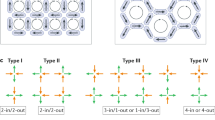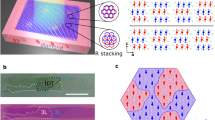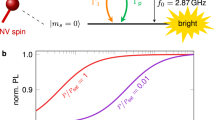Abstract
In frustrated spin systems, magnetic phase transitions underpin the formation of exotic, frustration-driven magnetic phases. Of great importance is the ability to manipulate these transitions to access specific phases, which in turn provides a means to discover and control novel phenomena. Artificial spin systems incorporating lithographically fabricated arrays of dipolar-coupled nanomagnets that enable real-space observation of the magnetic configurations provide such an opportunity. In particular, the kagome spin ice is predicted to exhibit two phase transitions, one of which is to a low-temperature phase whose long-range ground-state order has not been observed experimentally. To achieve this ordered state, we change the global symmetry of the artificial kagome system by selectively tuning the near-field nanomagnet interactions through nanoscale bridges at the lattice vertices. By precisely tuning the interactions, we are able to quantify the influence of frustration on the phase transition, finding that the driving force for spin and charge ordering depends on the degeneracy strength at the vertex.
This is a preview of subscription content, access via your institution
Access options
Access Nature and 54 other Nature Portfolio journals
Get Nature+, our best-value online-access subscription
$29.99 / 30 days
cancel any time
Subscribe to this journal
Receive 12 print issues and online access
$209.00 per year
only $17.42 per issue
Buy this article
- Purchase on Springer Link
- Instant access to full article PDF
Prices may be subject to local taxes which are calculated during checkout





Similar content being viewed by others
Data availability
The data that support the findings in this study are available via the Zenodo repository https://doi.org/10.5281/zenodo.5550504 (ref. 36). Source data are provided with this paper.
Code availability
The MC code, written in Fortran, can be requested at khofhuis@gmail.com or peter.derlet@psi.ch.
References
Heyderman, L. J. & Stamps, R. L. Artificial ferroic systems: novel functionality from structure, interactions and dynamics. J. Phys. Condens. Matter 25, 363201 (2013).
Nisoli, C., Moessner, R. & Schiffer, P. Colloquium: Artificial spin ice: designing and imaging magnetic frustration. Rev. Mod. Phys. 85, 1473–1490 (2013).
Skjærvø, S. H., Marrows, C. H., Stamps, R. L. & Heyderman, L. J. Advances in artificial spin ice. Nat. Rev. Phys. 2, 13–28 (2020).
Schiffer, P. & Nisoli, C. Artificial spin ice: Paths forward. Appl. Phys. Lett. 118, 110501 (2021).
Perrin, Y., Canals, B. & Rougemaille, N. Extensive degeneracy, Coulomb phase and magnetic monopoles in artificial square ice. Nature 540, 410–413 (2016).
Farhan, A. et al. Emergent magnetic monopole dynamics in macroscopically degenerate artificial spin ice. Sci. Adv. 5, eaav6380 (2019).
Gilbert, I. et al. Emergent reduced dimensionality by vertex frustration in artificial spin ice. Nat. Phys. 12, 162–165 (2016).
Lao, Y. et al. Classical topological order in the kinetics of artificial spin ice. Nat. Phys. 14, 723–727 (2018).
Sklenar, J. et al. Field-induced phase coexistence in an artificial spin ice. Nat. Phys. 15, 191–195 (2019).
Jensen, J. H., Folven, E. & Tufte, G. Computation in artificial spin ice. ALIFE 2018: The 2018 Conference on Artificial Life, 15–22 (MIT Press Direct, 2018).
Nomura, H. et al. Reservoir computing with dipole-coupled nanomagnets. Jpn. J. Appl. Phys. 58, 070901 (2019).
Hon, K. et al. Numerical simulation of artificial spin ice for reservoir computing. Appl. Phys. Express 14, 033001 (2021).
Sendetskyi, O. et al. Continuous magnetic phase transition in artificial square ice. Phys. Rev. B 99, 214430 (2019).
Anghinolfi, L. et al. Thermodynamic phase transitions in a frustrated magnetic metamaterial. Nat. Commun. 6, 8278 (2015).
Hofhuis, K. et al. Thermally superactive artificial kagome spin ice structures obtained with the interfacial Dzyaloshinskii–Moriya interaction. Phys. Rev. B 102, 180405(R) (2020).
Torrance, J. B., Lacorre, P., Nazzal, A. I., Ansaldo, E. J. & Niedermayer, C. Systematic study of insulator–metal transitions in perovskites RNiO3 (R=Pr,Nd,Sm,Eu) due to closing of charge-transfer gap. Phys. Rev. B 45, 8209–8212 (1992).
Shi, Y., Nisoli, C. & Chern, G. W. Ice, glass, and solid phases in artificial spin systems with quenched disorder. Appl. Phys. Lett. 118, 122407 (2021).
Östman, E. et al. Interaction modifiers in artificial spin ices. Nat. Phys. 14, 375–379 (2018).
Schánilec, V. et al. Bypassing dynamical freezing in artificial kagome ice. Phys. Rev. Lett. 125, 057203 (2020).
Farhan, A., Derlet, P. M., Anghinolfi, L., Kleibert, A. & Heyderman, L. J. Magnetic charge and moment dynamics in artificial kagome spin ice. Phys. Rev. B 96, 064409 (2017).
Möller, G. & Moessner, R. Magnetic multipole analysis of kagome and artificial spin-ice dipolar arrays. Phys. Rev. B 80, 140409(R) (2009).
Chern, G. W., Mellado, P. & Tchernyshyov, O. Two-stage ordering of spins in dipolar spin ice on the kagome lattice. Phys. Rev. Lett. 106, 207202 (2011).
Rougemaille, N. & Canals, B. Cooperative magnetic phenomena in artificial spin systems: spin liquids, Coulomb phase and fragmentation of magnetism–a colloquium. Eur. Phys. J. B 92, 62 (2019).
Canals, B. et al. Fragmentation of magnetism in artificial kagome dipolar spin ice. Nat. Commun. 7, 1–6 (2016).
Qi, Y., Brintlinger, T. & Cumings, J. Direct observation of the ice rule in an artificial kagome spin ice. Phys. Rev. B 77, 11446 (2008).
Zhang, S. et al. Crystallites of magnetic charges in artificial spin ice. Nature 500, 553–557 (2013).
Leliaert, J. et al. Fast micromagnetic simulations on GPU – Recent advances made with mumax3. J. Phys. D: Appl. Phys. 51, 123002 (2018).
Chioar, I. A. et al. Kinetic pathways to the magnetic charge crystal in artificial dipolar spin ice. Phys. Rev. B 90, 220407(R) (2014).
Saccone, M. et al. Towards artificial Ising spin glasses: Thermal ordering in randomized arrays of Ising-type nanomagnets. Phys. Rev. B 99, 224403 (2019).
Saccone, M. et al. Elevated effective dimension in tree-like nanomagnetic Cayley structures. Nanoscale 12, 189–194 (2019).
Gliga, S. et al. Emergent dynamic chirality in a thermally driven artificial spin ratchet. Nat. Mater. 16, 1106–1111 (2017).
Flechsig, U., Patthey, L. & Schmidt, T. Performance measurements at the SLS spectroscopy beamline. AIP Conf. Proc. 705, 316–319 (2004).
Le Guyader, L. et al. Studying nanomagnets and magnetic heterostructures with X-ray PEEM at the Swiss Light Source. J. Electron Spectros. Relat. Phenom. 185, 371–380 (2012).
Stöhr, J. et al. Element-specific magnetic microscopy with circularly polarized x-rays. Sci. (80-.). 259, 658–661 (1993).
Farhan, A. et al. Geometrical frustration and planar triangular antiferromagnetism in quasi-three-dimensional artificial spin architecture. Phys. Rev. Lett. 125, 267203 (2020).
Hofhuis, K. et al. Real-space imaging of phase transitions in bridged artificial kagome spin ice. Zenodo https://doi.org/10.5281/ZENODO.5550549 (2022).
Acknowledgements
K.H., S.H.S., H.A. and L.J.H. acknowledge support from the Swiss National Science Foundation (project no. 200020_172774). Part of this project was performed at the Surface/Interface: Microscopy (SIM) beamline of the Swiss Light Source, Paul Scherrer Institute, Villigen PSI, Switzerland.
Author information
Authors and Affiliations
Contributions
K.H. and L.J.H. conceived the project. K.H. fabricated the samples, and designed and performed the experiments with support from H.A., Z.L., S.P. and A.K. K.H. analysed and interpreted the data with support from P.M.D. and L.J.H., and P.M.D. wrote the MC code used by K.H. to perform the correlator analysis and phase diagram determination with support from S.H.S. K.H. wrote the manuscript with input from all authors.
Corresponding authors
Ethics declarations
Competing interests
The authors declare no competing interests.
Peer review
Peer review information
Nature Physics thanks Cristiano Nisoli, Susan Kempinger and the other, anonymous, reviewer(s) for their contribution to the peer review of this work.
Additional information
Publisher’s note Springer Nature remains neutral with regard to jurisdictional claims in published maps and institutional affiliations.
Supplementary information
Supplementary Information
Supplementary Figs. 1–7 with captions. The source data for these can be found in the Zenodo repository.
Supplementary Video 1
XMCD image sequence of thermally activated nanomagnets relaxing to thermal equilibrium for the bridged artificial kagome spin ice with Ja/Jb = 0.5187 (corresponding to Fig. 3). The top left panel displays the XMCD images, obtained as a function of time at constant temperature T = 320 K (TB = 310 K), starting from an initial frozen as-grown out-of-equilibrium ice-rule-obeying phase, which relaxes towards the equilibrium LRO phase. The extracted spin configurations are given in the top right panel, from which the vertex charge ordering is extracted and indicated with yellow dots in the bottom left panel, while blue dots indicate disordered charges. In the bottom right panel, the corresponding formation of moment loops is displayed, indicated with magenta and green for the left- and right-handed chirality of the loops. The images are recorded with a field of view of 20 μm in the XPEEM.
Supplementary Video 2
XMCD image sequence of thermally activated nanomagnets with magnetic moments fluctuating at 310 K (TB = 310 K) for the bridged artificial kagome spin ice with Ja/Jb = 0.847 (Tcrit = 340 K). The top left panel displays the series of XMCD images obtained as a function of time at constant temperature after equilibrating for 20 min. The extracted spin configurations are given in the top right panel, from which the vertex charge ordering is extracted and indicated with yellow dots in the bottom left panel, while blue dots indicate disordered charges. In the bottom right panel, the corresponding formation of moment loops is displayed, indicated with magenta and green for the left- and right-handed chirality of the loops. The images are recorded with a field of view of 20 μm in the XPEEM.
Supplementary Video 3
XMCD image sequence of thermally activated nanomagnets with magnetic moments fluctuating at 337 K (TB = 310 K) for the bridged artificial kagome spin ice with Ja/Jb = 0.847 (Tcrit = 340 K). The top left panel displays the series of XMCD images obtained as a function of time at constant temperature after equilibrating for 20 min. The extracted spin configurations are given in the top right panel, from which the vertex charge ordering is extracted and indicated with yellow dots in the bottom left panel, while blue dots indicate disordered charges. In the bottom right panel, the corresponding formation of moment loops is displayed, indicated with magenta and green for the left- and right-handed chirality of the loops. The images are recorded with a field of view of 20 μm in the XPEEM.
Supplementary Video 4
XMCD image sequence of thermally activated nanomagnets with magnetic moments fluctuating at 339 K (TB = 310 K) for the bridged artificial kagome spin ice with Ja/Jb = 0.847 (Tcrit = 340 K). The top left panel displays the series of XMCD images obtained as a function of time at constant temperature after equilibrating for 20 min. The extracted spin configurations are given in the top right panel, from which the vertex charge ordering is extracted and indicated with yellow dots in the bottom left panel, while blue dots indicate disordered charges. In the bottom right panel, the corresponding formation of moment loops is displayed, indicated with magenta and green for the left- and right-handed chirality of the loops. The images are recorded with a field of view of 20 μm in the XPEEM.
Source data
Source Data Fig. 1
Folder Fig1b contains the data points of Fig. 1b in Excel format (Fig1b.xlsx), a high-resolution image of how the data looks in png and pdf format. Fig1a_SEM.png is the original SEM image, and Fig1c is attached as a PDF as file Fig1c.
Source Data Fig. 2
Folder with the 18 individual pictures in png format. The file names indicate their panel, and part e contains the bridge width from left to right [w0, w15,w17, w18, wb0].
Source Data Fig. 4
Original images of Fig. 4a for the temperatures 310, 337 and 339 K (left to right), and the data points of Fig. 4b in Excel format (Fig4b.xlsx) with a corresponding image in png and pdf format. Figure 4c for the temperatures of 260, 310, 340, 370 and 400 K (left to right) are provided as well in png format.
Source Data Fig. 5
The data points of Fig. 5 in Excel format (Fig5.xlsx) with corresponding png and pdf format of how the data looks.
Rights and permissions
About this article
Cite this article
Hofhuis, K., Skjærvø, S.H., Parchenko, S. et al. Real-space imaging of phase transitions in bridged artificial kagome spin ice. Nat. Phys. 18, 699–705 (2022). https://doi.org/10.1038/s41567-022-01564-5
Received:
Accepted:
Published:
Issue Date:
DOI: https://doi.org/10.1038/s41567-022-01564-5
This article is cited by
-
Exploring the phase diagram of 3D artificial spin-ice
Communications Physics (2023)
-
Tailoring water structure with high-tetrahedral-entropy for antifreezing electrolytes and energy storage at −80 °C
Nature Communications (2023)
-
Real-space observation of ergodicity transitions in artificial spin ice
Nature Communications (2023)
-
Electrically programmable magnetic coupling in an Ising network exploiting solid-state ionic gating
Nature Communications (2023)
-
Long-range order seen at last
Nature Physics (2022)



